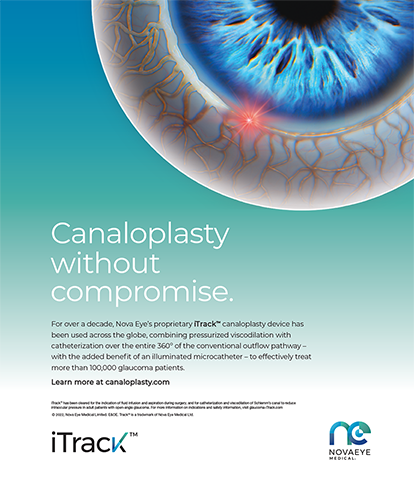Although improved fluidics have enabled the surgeon to emulsify a cataractous lens in a safer and more controlled fashion, the procedure for most surgeons still requires maneuvers in which the phaco tip leaves the central safe zone to travel deeper or more peripheral, increasing the likelihood of complications. Nuclear fracturing techniques, usually with the assistance of the fellow hand, permit the dismantling of the nucleus from an anterior approach, by either chopping or cracking. During this process, the surgeon attempts to keep the phaco needle in the central safe zone within the rhexis opening, where the distance from the corneal endothelium to the posterior capsule is greatest.
CHOPPING AND CRACKING
Once the initial nuclear split into halves has occurred, either the fellow-hand instrument (as in the case of chopping) or the phaco tip (as in the case of cracking), must be extended out to the periphery to complete the next fracture. Because the lens depth is less in the periphery, the surgeon runs the risk of a capsular break caused by the phaco tip or the fellow-hand instrument. In addition, a downward zonular pressure can occur here in order to make this split happen. Once quadrants are fashioned, the surgeon imbeds the phaco tip into the nuclear piece and attempts to pull it centrally before applying emulsification power. It is not uncommon for the nuclear quadrant to “snap back” away from the phaco port because the vacuum drawing force cannot overcome the three-sided hydrostatic adhesion that the quadrant has to the capsular fornix. The surgeon responds by either burying the phaco tip deeper into the nuclear piece or increasing the vacuum energy, which adds the risk of an inadvertent capsular tear or zonular dehiscence.
GONE FISHING
This peripheral “fishing” can also occur when a surgeon is left with an epinuclear bowl to emulsify. He or she may attempt a flip-over maneuver by extending an active phaco tip out toward the more narrowed capsular fornix to grab hold of the bowl's rim in an endeavor to cause it to fold upon itself. Passive techniques of reducing or unplugging the aspiration have been suggested as an alternative, but a sharp phaco needle is still in close proximity to the capsule.
USING THE FELLOW HAND
Surgeons who avoid fracturing altogether by “bowling out” the central nucleus usually use a tilting-up or flip-over maneuver of the remaining bowl or plate to bring it to the central safe zone. However, in the face of an average-sized rhexis opening and with a denser nucleus, a torsional stress on the zonules can occur with this action. The solution is to employ the fellow hand to break the adhesive forces and sweep the nuclear fragments to the waiting, centrally positioned, phaco tip. This action requires a side port instrument that has a curved shaft which conforms to the capsular fornix, and a polished bulbed tip to enable passage beneath nuclear quadrants or hemispheres without harming the underlying capsule. Nuclear portions can then be lifted up to the phaco port, keeping the posterior capsule at a distance. The Connor Wand™ from Rhein Medical Inc. (Tampa, FL) is such an instrument, offering the fellow hand an assistant's role in the emulsification process.
CRACK THE HEMISPHERE FROM BEHIND
Once the nucleus can freely spin following hydrodissection, the surgeon deeply scores it and cracks it in half, in the usual manner. A central bowl is then emulsified with low vacuum and aspiration settings. The surgeon passes the wand down through the crack and under the nuclear hemisphere. By lifting up the heminucleus with the wand and applying counter pressure with the quiet phaco tip, a “backcrack” occurs. Using the slender shaft of the wand, the surgeon is able to crack the hemisphere from behind, scooping out a quadrant from the capsular fornix, and lifting it up to the waiting phaco tip. At this point, it is safer to use higher vacuum and aspiration settings, because the phaco needle remains in the central safe zone. Once the surgeon has dialed the second hemisphere into position, the process is repeated as the surgeon slides the wand gently beneath each remaining nuclear fragment to be lifted.
CONCLUSION
All lens densities can be emulsified in the previously described manner. A denser heminucleus can be backcracked into smaller portions if desired. If the surgeon hydrodelineates before emulsification, and is left with an epinuclear bowl, the wand's shape and bulbed tip easily enable the bowl to be folded over or rolled upon itself for central emulsification. There is no need for a fishing expedition out to the capsular periphery. The wand has many applications as an intracapsular manipulator. When used in backcracking, it enhances safety by enabling phacoemulsification to occur centrally, with lower power settings while protecting the posterior capsule.


